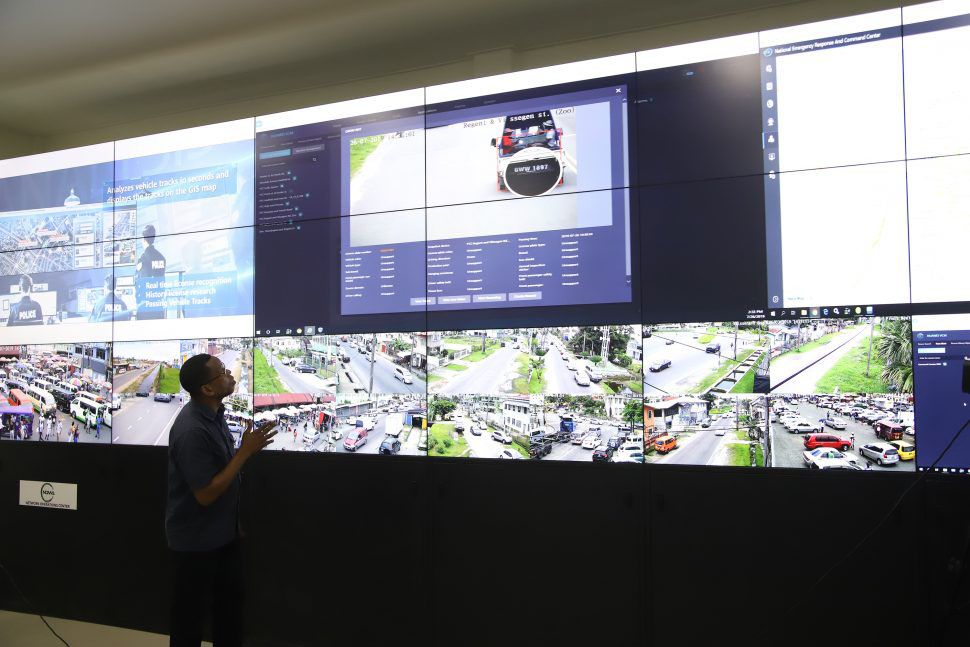Seeking to assuage privacy concerns, the Ministry of Public Telecommunications yesterday said that facial recognition technology will only be deployed at the country’s official ports of entry as part of the “Safe City” component of the National Broadband Project.
The ministry made the announcement in a statement which came after weeks of public concerns that fundamental rights could be under threat and that images gathered by the cameras could be improperly used. “Given the system design of Guyana’s current internal mechanisms, we reassure the public that this Safe City System will not violate anyone’s fundamental human rights,” it said. “For the first time, police and emergency services will have their own dedicated network for real-time communication to protect and assist the public, and for disaster relief,” it added.
It identified the Cheddi Jagan International Air-port, the Eugene F. Correia International Airport and the Moleson Creek Ferry Crossing as the ports of entry where the technology would be used.
“The specialised cameras at the official ports are very different from the CCTV cameras erected in public spaces. These cameras are the only ones capable of comparing images generated from automatic facial recognition software against databases administered by the Guyana Police Force, and by recognised international security agencies that Guyana has bilateral relationships with. While the cameras install-ed on the streets are of extremely high quality, they are not equipped for automatic facial recognition,” it explained, while noting that the Government of Guyana has no plans to install specialised facial recognition cameras in city streets anytime in the foreseeable future.
It further said that in a post 9/11 world of heightened security, facial recognition at ports of entry is now an international standard that most of the travelling public is aware of and subjects itself to. “The technologies and equipment installed in this Safe City project will remain in the possession of the National Emergency Response Command Centre (NERCC), and will only be shared with local law enforcement and foreign countries with whom Guyana has bilateral agreements for security cooperation,” it added.
The ministry noted that it first introduced the Safe City initiative to the nation more than two years ago as a valuable resource for the security forces in their fight against crime and reiterated that the new system is designed solely for everyone’s safety and security, and is not intended to infringe an individual’s right to privacy.
It explained that the Safe City initiative provides for the construction of an integrated NERCC, with a network of CCTV cameras located around Georgetown.
The main purpose of the NERCC, the statement said, is to enhance the safety and security of communities by providing security services with increased operational capabilities. Its objectives include: Efficient deployment of law enforcement staff; Better multi-agency response to incidents and emergencies; Increased success and efficiency in bringing criminals to justice; Enhanced security coordination for major public events; Efficient disaster management; Increased awareness of threats to public security; Establishing integrity of data and information for the Criminal Justice system; Presentation of ‘hard’ evidence in court cases; Improved response time for all emergency services; and establishment of a single response number, e.g. 911, for any emergency.
Guyanese operators of the Command Centre, the ministry added, are currently being trained by a consulting team of British security experts who are developing the Standard Operating Procedures (SOPs) to guide the operations of the Centre.
According to the ministry, the Safe City programme operates on an independent government-owned fibre optic network managed by the National Data Management Authority (NDMA) and there are no points of entry or gateways for any third party – individuals or companies. “This network is physically independent with all trunking and cabling standing alone. It is physically isolated from the Government platform which provides connectivity to Government institutions, agencies, schools, health and other public facilities,” it further said.
Additionally, access to the CCTV network of cameras will only be possible by authorised security personnel who are “stringently vetted” before they are assigned to the NERCC. The statement noted that their operations will be guided by the standard operating procedures (SOPs) being developed by the consulting team of UK security experts. “These procedures will include adherence to an agreed set of security standards and operating practices, with strict, limited and supervised access to the operations of the Command Centre. Strong penalties are in place for persons who breach these requirements,” it added.
According to the statement, the personal data stored by agencies such as the Central Immigration and Passport Office, the Guyana Elections Com-mission and the Guyana Revenue Authority have not been and will not be shared under the project. “In fact, the laws and regulations that govern these agencies prevent unauthorised sharing of such data,” it pointed out.






